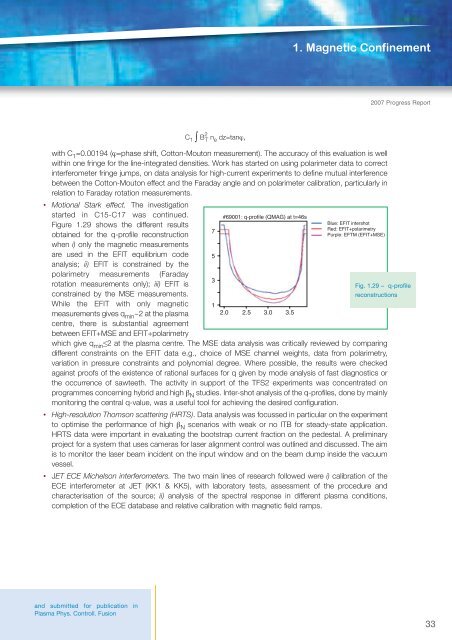Fusion Programme - ENEA - Fusione
Fusion Programme - ENEA - Fusione
Fusion Programme - ENEA - Fusione
- No tags were found...
You also want an ePaper? Increase the reach of your titles
YUMPU automatically turns print PDFs into web optimized ePapers that Google loves.
1. Magnetic Confinement2007 Progress ReportC 1 ∫ B 2 T n e dz=tanϕ,with C 1 =0.00194 (ϕ=phase shift, Cotton-Mouton measurement). The accuracy of this evaluation is wellwithin one fringe for the line-integrated densities. Work has started on using polarimeter data to correctinterferometer fringe jumps, on data analysis for high-current experiments to define mutual interferencebetween the Cotton-Mouton effect and the Faraday angle and on polarimeter calibration, particularly inrelation to Faraday rotation measurements.• Motional Stark effect. The investigationstarted in C15-C17 was continued.Figure 1.29 shows the different resultsobtained for the q-profile reconstructionwhen i) only the magnetic measurementsare used in the EFIT equilibrium codeanalysis; ii) EFIT is constrained by thepolarimetry measurements (Faradayrotation measurements only); iii) EFIT isconstrained by the MSE measurements.While the EFIT with only magneticmeasurements gives q min ~2 at the plasmacentre, there is substantial agreementbetween EFIT+MSE and EFIT+polarimetry7531#69001: q-profile (QMAG) at t=46s2.0 2.5 3.0 3.5Blue: EFIT intershotRed: EFIT+polarimetryPurple: EFTM (EFIT+MSE)Fig. 1.29 – q-profilereconstructionswhich give q min ≤2 at the plasma centre. The MSE data analysis was critically reviewed by comparingdifferent constraints on the EFIT data e.g., choice of MSE channel weights, data from polarimetry,variation in pressure constraints and polynomial degree. Where possible, the results were checkedagainst proofs of the existence of rational surfaces for q given by mode analysis of fast diagnostics orthe occurrence of sawteeth. The activity in support of the TFS2 experiments was concentrated onprogrammes concerning hybrid and high β N studies. Inter-shot analysis of the q-profiles, done by mainlymonitoring the central q-value, was a useful tool for achieving the desired configuration.• High-resolution Thomson scattering (HRTS). Data analysis was focussed in particular on the experimentto optimise the performance of high β N scenarios with weak or no ITB for steady-state application.HRTS data were important in evaluating the bootstrap current fraction on the pedestal. A preliminaryproject for a system that uses cameras for laser alignment control was outlined and discussed. The aimis to monitor the laser beam incident on the input window and on the beam dump inside the vacuumvessel.• JET ECE Michelson interferometers. The two main lines of research followed were i) calibration of theECE interferometer at JET (KK1 & KK5), with laboratory tests, assessment of the procedure andcharacterisation of the source; ii) analysis of the spectral response in different plasma conditions,completion of the ECE database and relative calibration with magnetic field ramps.and submitted for publication inPlasma Phys. Controll. <strong>Fusion</strong>33













